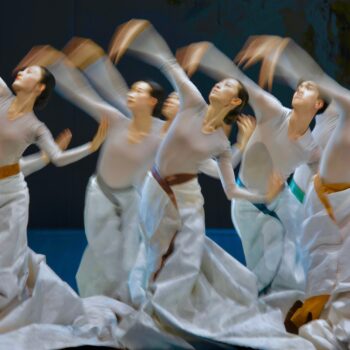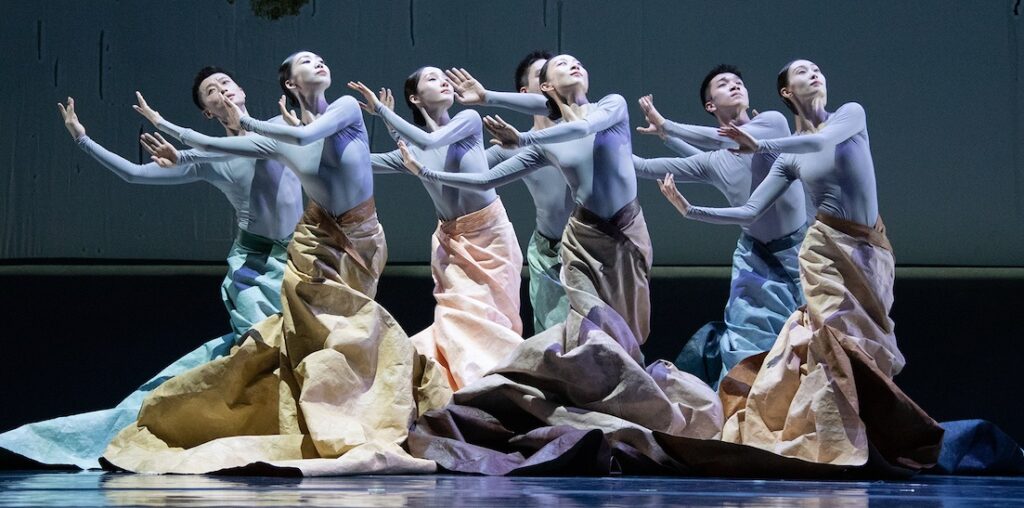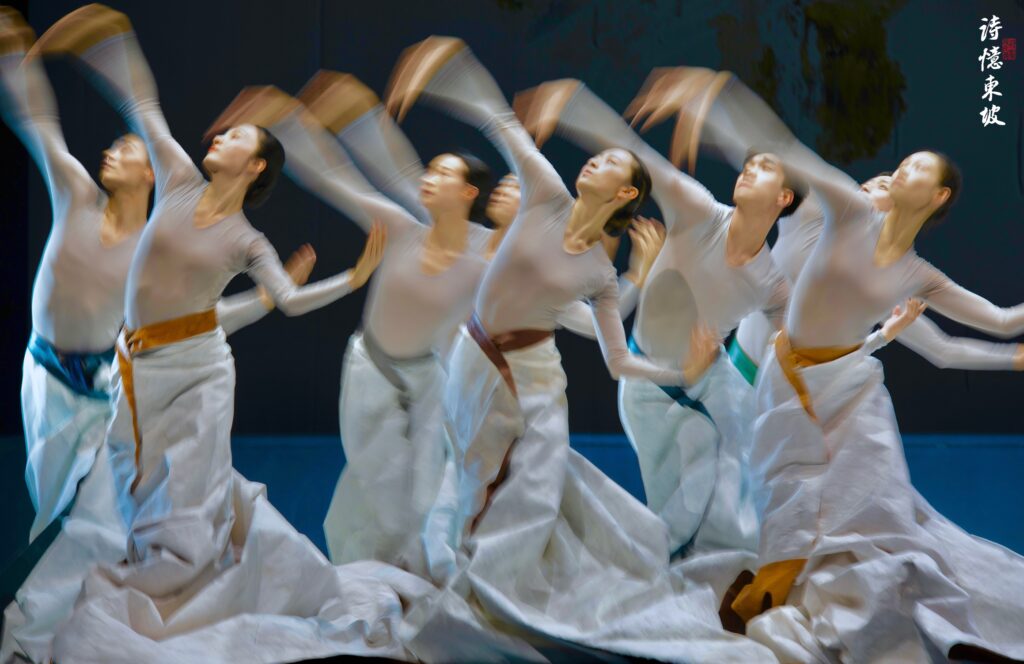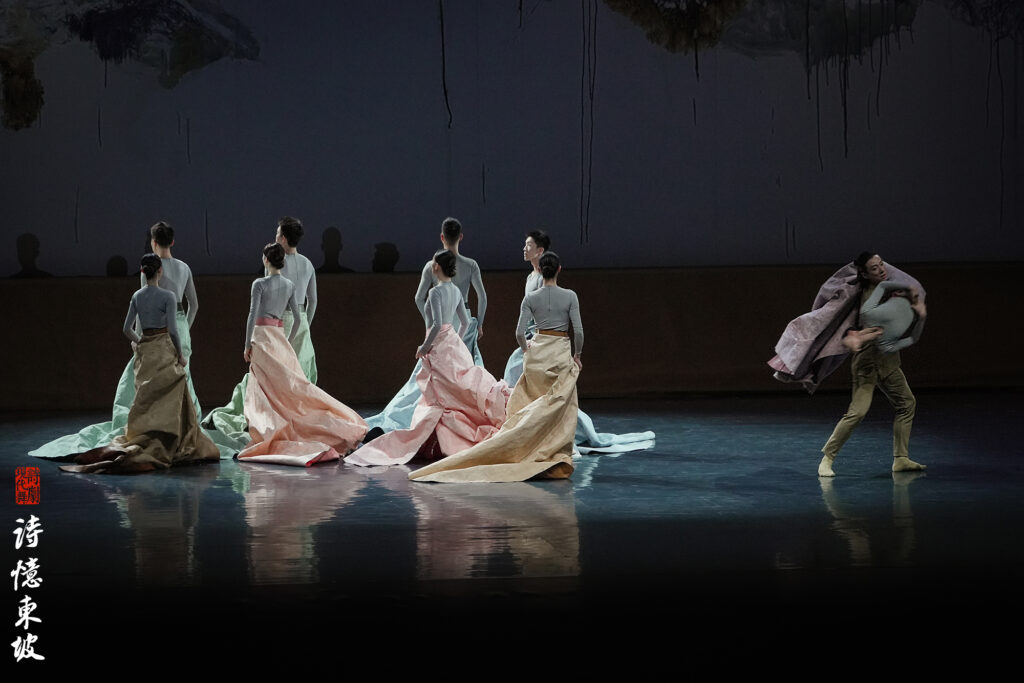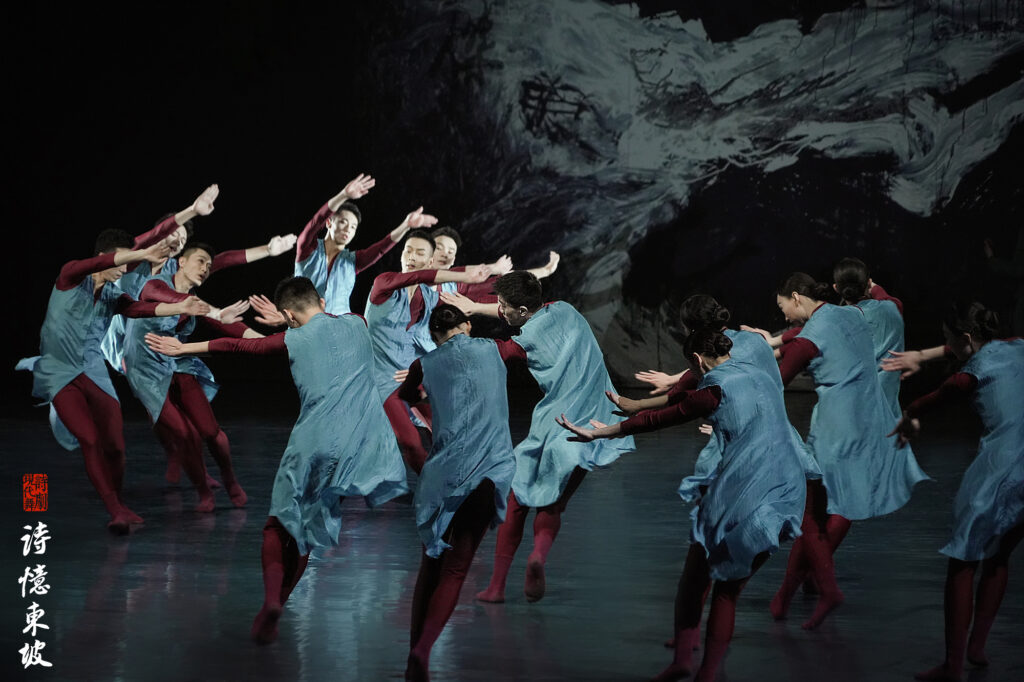The lavish, dreamlike vision of Shen Wei graced the David Koch Theater last weekend. Co-produced by the China Arts and Entertainment Group (CAEG) and American Dance Festival, Dongpo: Life in Poems melds Shen Wei’s swirling choreography, spectacularly multileveled sets, and otherworldly costumes into a magical experience.
The show loosely depicts the journey of Song Dynasty poet Dongpo (1037–1101) in six acts. It’s a lifelong journey, filled with wonder and sorrow—but no wars, no famine. This was a journey of peace, of honoring nature, and of self-reflection. Like Dongpo, Shen Wei is an artist of multiple roles: choreographer, painter, playwright, director, and poet. Throughout the many changes of mood and scene, Shen Wei has sustained a visual experience of exquisite beauty.
I offer here, not a review, but notes on some of the elements that contributed to the aesthetic wonder.
The journey: It began with a sole figure, perched high up behind a scrim of a sketch of bamboo. Facing to the right, he walks slowly, setting out on a journey. We see a map that is crisscrossed many times, presumably to the places Dongpo traveled to. After many dreamlike adventures, it ends the same way, with the man having moved only a little further toward his destination.
Telling the story: Lead dancer Su Peng appears in a circle of light, also high up. With his skin painted white, he seems to absorb light as his arms and spine move in circular pathways…a lunar being calling out his story. With mesmerizing fluidity, Su Peng is telling the story and being the story at the same time.
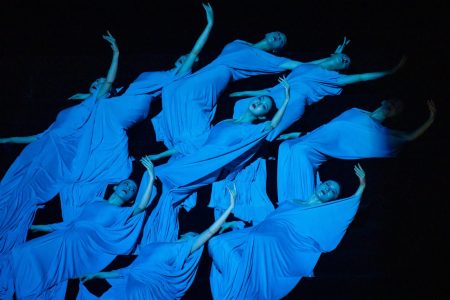 The illusions: The dancers are sometimes lifted into the stratosphere of the stage space. At one point, nine men in three rows stage left and nine women in a circle stage right appear as glowing blue paintings floating in the air. Even when they start moving, it seems like they may be films and not people. But they are indeed alive, which is only discernible when the men step ultra-slowly across the space to infiltrate the women’s circle. This kind of illusion is, of course, accomplished by the lighting designer, Xiao Lihe, who has studied with Jennifer Tipton!
The illusions: The dancers are sometimes lifted into the stratosphere of the stage space. At one point, nine men in three rows stage left and nine women in a circle stage right appear as glowing blue paintings floating in the air. Even when they start moving, it seems like they may be films and not people. But they are indeed alive, which is only discernible when the men step ultra-slowly across the space to infiltrate the women’s circle. This kind of illusion is, of course, accomplished by the lighting designer, Xiao Lihe, who has studied with Jennifer Tipton!
The music: The performance alternated between a recording of Western-sounding orchestral music composed by Chen Qigang, and a live Guqin player, Zhao Xiaoxia. The traditional Guqin is a seven-stringed plucked instrument that sounds a bit like a dulcimer. In one scene, an operatic voice lets loose, veering toward a Meredith Monk–style looping and ricocheting.
The 23 dancers: Members of China Oriental Performing Arts group and Meishan Song and Dance Theatre, the dancers all have a formality that enabled them to guide us on this ceremonial journey. They executed Shen Wei’s choreography of whipping circles and extended lines with great flourish while keeping a sense of being close to nature. Su Peng commanded the stage with every gesture. I learned later that these dancers have never done contemporary dance before!
The costumes. Some of the costumes had a magnificent sculptural quality. In Act IV, a series of moving sculptures trudge onto the stage…large indecipherable statues in pale pastels. Each sculpture turned out to be two entwined people wearing voluminous skirts. This was a slow march of otherworldly figures.
Another aspect of the costumes: In Act I, the men and women wore the same red unitards, and later they wore the same blue tunics over burgundy leotard and tights. Considering the highly gendered presentation of most Chinese Classical Dance—and most ballet and modern dance too—this decision was refreshing.
The humor. To break with the ceremonial quality, a series of wheeled devices crossed from stage right to stage left: first a kind of rickshaw, then a bicycle, then a scooter, and finally a skateboard. Later, one person whizzed down a skateboard ramp. A little history of wheels in two minutes!
The tangled cloud: In a clever animation, a hand quickly drew brush-strokes, first in one color ink, then another. What looked at first like Chinese letters turned into a cluster of tightly intersecting curved lines. In the next scene, this little tangle became a cloud overhead that slowly passed from stage right to stage left before disappearing.
The poetry. Shen Wei chose a few fragments of Dongpo’s thousands of poems to appear on the scrim. They seemed to be mostly about time passing and an affinity with nature. I caught these lines:
• “A new fire to brew fresh tea will set our minds at peace.”
• “Even if we met you might not know me so frayed; my face is covered with dust; my hair is grayed.”
• “May all of us far apart be blessed with longevity, So that we can forever share the moon’s beauty.”
Looking ahead: With the magnificent Dongpo: Life in Poems still in my mind’s eye, I look forward to re-seeing Shen Wei’s signature piece Map (2006), as part of Spring Dances at Juilliard. Very different from Dongpo, Map has casual costumes and all the dancing on one level. But the intricate phrases and patterns accumulate a certain force over forty-five minutes. For a special pleasure, the Juilliard orchestra will play the accompaniment, Steve Reich’s Desert Music, live.
Featured Leave a comment
